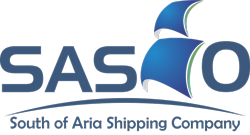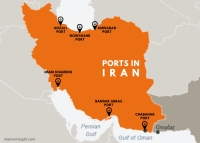1. Bandar Anzali: The Maritime Trade Capital of Northern Iran
Located in Gilan Province on the southwestern shores of the Caspian Sea, Bandar Anzali is the largest and most significant of the northern ports in Iran. Spanning approximately 71 hectares with 12 operational docks, it benefits from a temperate, humid climate and proximity to the ecologically rich Anzali Lagoon. Its strategic position in the North-South Corridor makes it a cornerstone of Iran’s maritime trade network.
Bandar Anzali is a powerhouse for international trade, handling exports of agricultural products (e.g., pistachios, dried fruits), industrial goods, petroleum, and petrochemicals. It also facilitates imports of textiles, tea, sugar, grains, and construction materials. As a Free Trade Zone, it attracts foreign investment and supports robust freight forwarding and logistics operations across Iran.
Trade Routes to Neighboring Countries:
- Russia: Connected to Astrakhan and Lagan ports, Anzali is a primary gateway for exporting agricultural and industrial goods to Russia and onward to European markets.
- Azerbaijan: Direct maritime links with Baku enable efficient trade and transshipment to the Caucasus and Eastern Europe.
- Kazakhstan and Turkmenistan: Ports like Aktau (Kazakhstan) and Turkmenbashi
- (Turkmenistan) are accessible via the Caspian Sea, supporting exports of food and industrial products.
- Central Asia and Europe: Through the North-South Corridor, Anzali connects to Central Asian markets (Uzbekistan, Tajikistan) and Europe via Russia.
Export Role: As one of the most developed northern ports in Iran, Bandar Anzali is a key exporter, leveraging its infrastructure and strategic location to drive Iran’s trade with the Caspian region and beyond.
2. Bandar Astara: The Border Trade and Fisheries Gateway
Situated in the northernmost part of Gilan Province, Bandar Astara lies on the western shores of the Caspian Sea, adjacent to Iran’s border with Azerbaijan. Its temperate climate and proximity to both maritime and land borders make it a unique hub among the northern ports in Iran. Well-connected by road to Rasht and Ardabil, Astara is a vital link for cross-border trade.
As one of the most active transshipment hubs among northern ports in Iran, Astara excels in exporting fisheries products, particularly fish and caviar. Its local markets and commercial complexes also support cross-border trade and tourism.
Trade Routes to Neighboring Countries:
- Azerbaijan: Proximity to Baku and the Astara-Astara land border facilitates seamless trade of fisheries and local products.
- Russia and the Caucasus: Via Azerbaijan, Astara connects to Russian ports like Astrakhan and supports transshipment to the Caucasus.
- Europe: Emerging rail connections (e.g., Rasht-Astara railway) enhance its potential as a transit point to Europe through the Caucasus.
Export Role: While Astara’s export activities focus on fisheries and border trade, its role is smaller compared to larger northern ports in Iran like Anzali and Amirabad due to limited infrastructure.
Read more information in this article: “Boost Trade with Transit Services through Iran to CIS Countries”
3. Bandar Nowshahr: The Agricultural Export Hub Near Tehran
Located in western Mazandaran Province, 200 km from Tehran, Bandar Nowshahr is a key port on the southern shores of the Caspian Sea. Covering 45 hectares with a dock depth of 5.5 meters (planned to increase to 5.6 meters), it benefits from proximity to Tehran and a local airport. Its temperate climate and nearby attractions, like Sisangan Forest Park, add to its appeal.
Nowshahr is a critical hub for exporting Mazandaran’s agricultural products, such as citrus fruits and rice, as well as industrial goods like steel products. Handling around 500 commercial vessels annually, it is one of the busiest northern ports in Iran. Plans for expanded docks, cold storage, and export terminals further enhance its capacity.
Trade Routes to Neighboring Countries:
- Russia: Links to Astrakhan and Lagan ports support exports of agricultural and industrial goods.
- Kazakhstan and Turkmenistan: Maritime connections to Aktau and Turkmenbashi facilitate trade in food and agricultural products.
- Central Asia: Nowshahr’s road and sea links provide access to Central Asian markets.
Export Role: Its proximity to Tehran and robust infrastructure make Nowshahr a vital export hub among northern ports in Iran, particularly for agricultural goods.
4. Fereydunkenar Coastal Area: The Fisheries and Ecotourism Haven
Located in Mazandaran Province between Babolsar and Mahmudabad, the coastal area of Fereydunkenar lies on the southern shores of the Caspian Sea. Its 10-km sandy beach and status as a critical habitat for the endangered Siberian Crane make it ecologically significant. Accessible by road from Mahmudabad, Babol, and Amol, it is a popular destination for local tourism and nature enthusiasts.
Fereydunkenar is renowned for its local fisheries, particularly caviar-producing sturgeon, supporting traditional and modern fishing practices. It plays a key role in the regional economy of northern Iran, focusing on local trade and ecotourism rather than large-scale international commerce. The area's wetlands and bird-watching opportunities, especially during the Siberian Crane migration, enhance its appeal as a tourism hub.
Trade Routes to Neighboring Countries:
- Russia: Limited local fisheries trade with Astrakhan and Lagan via Caspian Sea routes, primarily through intermediaries.
- Kazakhstan and Turkmenistan: Minimal connections to Aktau and Turkmenbashi for local fish products, with no significant export infrastructure.
- Central Asia: No notable transshipment role to Central Asian markets due to limited port facilities.
Export Role: Fereydunkenar’s activities center on local fisheries and ecotourism, with a smaller scale compared to major northern ports in Iran like Bandar Anzali and Amirabad. Its contribution to exports is minimal, focusing on regional markets rather than international trade.
5. Bandar Amirabad: The Industrial and Logistics Powerhouse
Located northeast of Behshahr in Mazandaran Province, Bandar Amirabad is the largest of the northern ports in Iran, covering 1,060 hectares (expandable to 2,120 hectares) with 15 docks. As the only northern port connected to Iran’s national railway network, it holds a strategic position in the North-South Corridor. Its temperate climate and proximity to energy resources enhance its significance.
Amirabad is Iran’s premier industrial port in the north, specializing in exports of minerals, petrochemicals, and containerized goods. Designed to handle 5 million tons of cargo annually, it supports roll-on/roll-off (RoRo) operations and is linked to regional refineries.
Trade Routes to Neighboring Countries:
- Russia: Direct links to Astrakhan and Lagan for industrial and petrochemical exports.
- Kazakhstan and Turkmenistan: Connections to Aktau and Turkmenbashi support industrial and energy trade.
- Central Asia, Far East, and Europe: The North-South Corridor links Amirabad to Central Asia, the Far East, and Europe.
Export Role: Amirabad’s advanced infrastructure and rail connectivity make it a leading export hub among northern ports in Iran for industrial and energy products.
6. Bandar Neka: The Energy Trade Specialist
Situated in eastern Mazandaran near Behshahr, Bandar Neka lies on the southern shores of the Caspian Sea. Its proximity to the Chalous oil reservoirs and direct pipeline connections make it a specialized energy hub among northern ports in Iran. Accessible by major roads, it benefits from a temperate climate.
Neka focuses on loading and unloading petroleum and petrochemical products, including oil swap operations with neighboring countries. Its role in non-energy exports is limited.
Trade Routes to Neighboring Countries:
- Russia: Petroleum exports and swaps to Astrakhan and Lagan.
- Kazakhstan and Turkmenistan: Energy trade with Aktau and Turkmenbashi.
- Central Asia: Limited transshipment of energy products to Central Asian markets.
Export Role: Neka’s specialized focus on energy makes it a niche but critical player among northern ports in Iran.
7. Bandar Gaz: The Tranquil Fisheries and Tourism Port
Located in Golestan Province on the southeastern shores of the Caspian Sea, Bandar Gaz is a small port near Gaz city. Its temperate climate and scenic surroundings make it a local gem among northern ports in Iran. Road connections to Gorgan enhance its accessibility.
Bandar Gaz primarily supports local fishing and tourism, with minimal international trade activity. Its focus is on sustaining the regional economy and promoting coastal tourism.
Trade Routes to Neighboring Countries:
- Turkmenistan: Proximity to Krasnovodsk allows limited local trade.
- Russia and Kazakhstan: Minimal connections to Astrakhan and Aktau for fisheries products.
- Export Role: Bandar Gaz has a limited export role, focusing on local activities rather than international trade among northern ports in Iran.
8. Bandar Turkmen: The Cultural and Tourism Trade Destination
Positioned in western Golestan Province near the Gorgan Gulf, Bandar Turkmen is a culturally rich port on the southeastern Caspian Sea. Known for its Turkmen heritage and traditional markets, it is well-connected by road to Gorgan.
Bandar Turkmen focuses on coastal tourism and local trade, with minor exports of traditional Turkmen handicrafts. It is more a tourism destination than a commercial hub among northern ports in Iran.
Trade Routes to Neighboring Countries:
- Turkmenistan: Close ties with Krasnovodsk support local trade and cultural exchanges.
- Russia and Kazakhstan: Limited trade with Astrakhan and Aktau for local products.
- Export Role: Bandar Turkmen’s export activities are minimal, prioritizing tourism and local commerce over international trade.
Conclusion
Together, these northern ports in Iran form a dynamic network, strengthening the country’s position in regional and global maritime trade.
For businesses aiming to navigate Iran’s logistics landscape efficiently in 2025, especially when it comes to transport, customs, and freight coordination, our Complete Logistics Guide is a must-read.
If you're looking for a trusted Iranian partner to manage your cargo shipments to or from northern ports such as Bandar Anzali or Amirabad, SASCO offers end-to-end freight forwarding solutions with expert local knowledge.
? Contact SASCO today to optimize your cargo operations and unlock smooth access to the Caspian trade routes.







